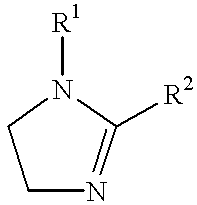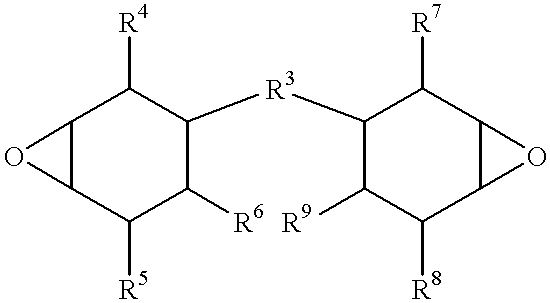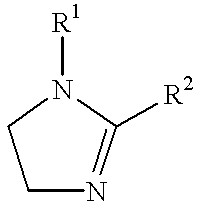Stabilized phosphate ester-based functional fluid compositions
a technology of functional fluids and phosphate ester, which is applied in the direction of lubricant compositions, base materials, chemistry apparatus and processes, etc., can solve the problems of aircraft hydraulic fluids commonly contaminated with moisture, acid scavengers depleted, erosion problems may also be expected to increase, etc., to inhibit the oxidation of fluid composition components
- Summary
- Abstract
- Description
- Claims
- Application Information
AI Technical Summary
Benefits of technology
Problems solved by technology
Method used
Image
Examples
example 1
A hydraulic fluid having the composition set forth in Table 1 was prepared by mixing at ambient temperature in a 50 gallon stainless steel tank agitated with a 25 horsepower agitator having an anchor type impeller. The phosphate ester components were introduced into the tank first and, after a 30 minute period of initial mixing, the other additives were added in the sequence indicated in Table 2.
TABLE 2 Basis: 100 Gram Basis: Batch 80 Gallon Batch Component Grams Grams / Pounds Tributyl Phosphate, 49.0135 148,216.8 / 326.8 Neat Dibutyl Phenyl 26.43 79,652.2 / 175.6DRUM Phosphate of 2(-220#) Low Diphenyl Content (Less Than 2% By Weight) Methacrylate Ester 16.56 50,077 / 110.4 Viscosity Index 22684.9 Improver (PA6477, gSLDS 45.3% solids in 54.7% tributyl phosphate) 3,4 Epoxycyclohexane 6.3 19,051 / 42 Carboxylate FC98 [Potassium .05 151.2 / Perfluorooctylsulfonate (FC98)] Benzotriazole type .05 151.2 / Copper Corrosion Inhibitor (P57068, Petrolite (50% Active), EX1663 Iron Corrosion Inhibitor .05...
example 2
A second aircraft hydraulic fluid composition was prepared in the manner generally described in Example 1. The composition of this fluid is set forth in Table 3.
TABLE 3 Basis: 100 Gram Basis: 80 Gallon Batch Batch Component Grams Grams / Pounds Tributyl Phosphate 50.5988 152,999.3 / 337.3 Dibutyl Phenyl 24.0947 72,862.3 / 106.63 Phosphate of Low Diphenyl Content (Less Than 2% By Weight) Methacrylate Ester 22,684.9 Viscosity Index gSLDS Improver (PA6477, Total 43.8% solids / 56.2% tributyl phosphate) 3,4 Epoxycyclohexane 6.3 19,051 / 42 Carboxylate .Iadd.FC98.Iaddend..[.Potassium .05 151.2 / Perfluorooctylsulfonate (FC98).]. Benzotriazole Type .05 151.2 / Copper Corrosion Inhibitor (P57068, Petrolite; (50% Active) Iron Corrosion Inhibitor .05 151.2 / (90-31001, Petrolite (50% Active), EX1663 Dye .001 3.024 / Potassium Phenate .035 105.84 / .Iadd.Bis-(3,5-di-tert-butyl 0.90 2,722 / 6 4-hydroxyphenyl) methane (Ethanox .RTM. 702).Iaddend. Di(p-octylphenyl)amine .45 1,361 / 3 Dow-Corning .0005 1,512 / Antif...
example 3
Tests were conducted comparing the thermal, oxidative and hydrolytic stability of the hydraulic fluid compositions of Examples 1 and 2 with commercially available hydraulic fluids. In each of these tests, a 301 stainless steel tube was filled to 80% capacity with the fluid to be tested. The temperature was maintained constant in each test. Compartative tests were run at 50.degree. F. and 275.degree. F., and further tests of the composition of the invention were run at 300.degree. F. In all tests, five corrosion coupons were immersed in the fluid.
In some of the tests, the head space in the tube was filled with air, in others it was filled with nitrogen. After each tube was filled with the appropriate test composition, it was capped and heated to a predetermined test temperature and maintained at that temperature so that hydrolytic stability at such temperature could be determined. Each tube was monitored over time and samples were taken to follow trends in the fluid's chemical compos...
PUM
| Property | Measurement | Unit |
|---|---|---|
| temperatures | aaaaa | aaaaa |
| temperatures | aaaaa | aaaaa |
| temperatures | aaaaa | aaaaa |
Abstract
Description
Claims
Application Information
 Login to View More
Login to View More - R&D
- Intellectual Property
- Life Sciences
- Materials
- Tech Scout
- Unparalleled Data Quality
- Higher Quality Content
- 60% Fewer Hallucinations
Browse by: Latest US Patents, China's latest patents, Technical Efficacy Thesaurus, Application Domain, Technology Topic, Popular Technical Reports.
© 2025 PatSnap. All rights reserved.Legal|Privacy policy|Modern Slavery Act Transparency Statement|Sitemap|About US| Contact US: help@patsnap.com



